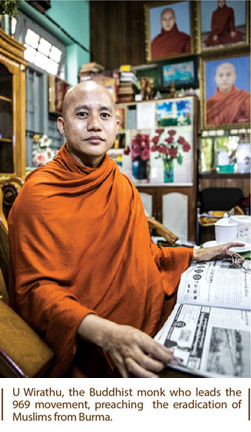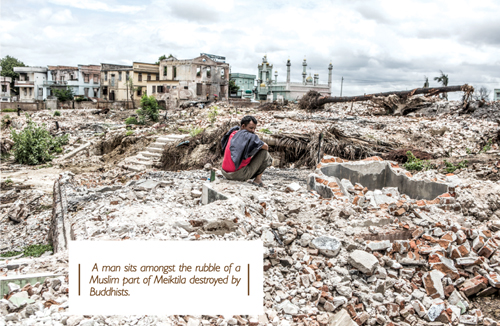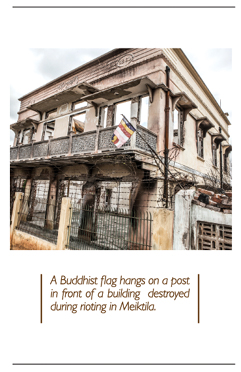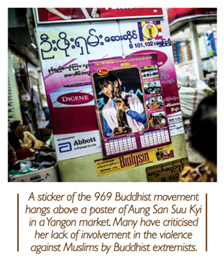Originally published in Citylife, September 2013
It was not so long ago that Burmese monks dressed in saffron robes organised brave protests and peaceful processions against the brutal military junta led by General Than Shwe. It was dubbed the Saffron Revolution.
In 2007, the monks’ Gandhian non-violent resistance was watched with awe, and commanded the respect of millions around the globe.But these images etched in our collective memory are hard to square with an ugly new reality: Buddhist gangs setting Muslims communities ablaze; acts of collective arson and racist brutality, with some monks playing a vanguard role in instigating this anti-Muslim campaign.
How can the same religion known throughout the world for its commitment to peace, meditation, and reflection engage in hate-filled sermons against the Muslim minority? What has happened to the world religion that is above all other world religions, devoted to peace and non-violence? Has the year of the heroic monks of 2007 metamorphosed into some devilish distortion of Theravada Buddhism, forsaking tolerance and respect for all humanity, into a crassly xenophobic new creed that endorses killing Muslims in the name of Buddhism?
Most of the media coverage, Burmese and international alike, has narrowly focused on the anti-Muslim rantings spewed out by Buddhist monk U Wirathu, from a monastery near Mandalay. The leader of the ultra-nationalist movement known as “969” has claimed that Muslims commit virtually all the rapes reported in Burma, that their mosques and assets are being secretly financed by the Saudis, and that they will eventually take over the whole country.
Not the Time for Calm
Buddha preached calm and contemplation but Wirathu’s agenda calls for the opposite. “Now is not the time for calm,” declares the 46-year-old monk as he denigrates Muslims. “Now is the time to rise up, to make your blood boil.” (This quote was reported in the July 1st edition of TIME Magazine, which featured a cover shot of the angry monk headlined “The Face of Buddhist Terror.” The issue was banned inside Burma.) It was not so long ago that Burmese monks dressed in saffron robes organised brave protests and peaceful processions against the brutal military junta led by General Than Shwe. It was dubbed the Saffron Revolution.
It was not so long ago that Burmese monks dressed in saffron robes organised brave protests and peaceful processions against the brutal military junta led by General Than Shwe. It was dubbed the Saffron Revolution.
In 2007, the monks’ Gandhian non-violent resistance was watched with awe, and commanded the respect of millions around the globe.
But these images etched in our collective memory are hard to square with an ugly new reality: Buddhist gangs setting Muslims communities ablaze; acts of collective arson and racist brutality, with some monks playing a vanguard role in instigating this anti-Muslim campaign. How can the same religion known throughout the world for its commitment to peace, meditation, and reflection engage in hate-filled sermons against the Muslim minority? What has happened to the world religion that is above all other world religions, devoted to peace and non-violence? Has the year of the heroic monks of 2007 metamorphosed into some devilish distortion of Theravada Buddhism, forsaking tolerance and respect for all humanity, into a crassly xenophobic new creed that endorses killing Muslims in the name of Buddhism?
Most of the media coverage, Burmese and international alike, has narrowly focused on the anti-Muslim rantings spewed out by Buddhist monk U Wirathu, from a monastery near Mandalay. The leader of the ultra-nationalist movement known as “969” has claimed that Muslims commit virtually all the rapes reported in Burma, that their mosques and assets are being secretly financed by the Saudis, and that they will eventually take over the whole country.
Extremist Buddhist monks, led by the publicity hungry Wirathu, are preaching a brand of pure Buddhist nation-state, where there is no place for the followers of Islam. Muslim shops and homes in Lashio, Shan State were the most recent victims of a Buddhist motorbike gang in June. “The government and the police are not doing anything at all to clamp down on extremist hate propaganda against Muslims,” commented Sai Latt, a Shan researcher and PhD candidate at Simon Fraser University in Canada.
The killings of Muslim Rohingyas in Rakhine state in the west of the country, which started the violence in 2012, has spread this year to the wider Muslim population. In March, systemic arson razed to the ground 1,300 Muslim houses and shops in the central town of Meikhtila. Armed Buddhist gangs later brought terror to 14 peaceful Muslim communities in towns and villages in central Burma, setting fire to homes, shops, and mosques. Acting with total impunity, they moved south to Pegu division and unleashed another wave of havoc in Okkan District, resulting in thousands more fleeing from their communities.
Patterns of Violence
Nationwide speeches and rallies led by Wirathu, which more closely resembled political campaigns than calls to enlightenment, had invariably occurred in the vicinity of Meiktila, Okkan and other districts just before the violence broke out. But is the violence the inevitable result of reformist changes in the country, now that freedom of expression has come to Burma alongside the emergence of a quasi-civilian government, after 50 years of brutal military repression?
Certainly it is the latter that presidential spokesman and deputy minister of information Ye Htut would have us believe. “We cannot avoid this time of chaos,” Ye Htut told AFP news agency. He insisted that the wave of hate speech and violence targeting Muslims was simply the “ugly by-product” of new freedoms allowed by the reformist government. Sai Latt, however, claims that there is a clearly orchestrated pattern to these anti-Muslim attacks.
“Prior to the riots, anti-Muslim literature arrives in a town, followed by monks preaching ‘969 sermons in the vicinity,” recalls Sai. “On the day when violence breaks out, truckloads of strangers, including monks, have appeared on the scene. In each case an incident takes place that triggers the anger of the Buddhists.”
Originally, the numerals “969” symbolised the virtues of the Buddha, Buddhist practices and the Buddhist community. But now, 969 has been hijacked as a symbol of anti-Muslim agitation.
Shortly after the strangers arrive, all hell breaks loose. Angry mobs, crying “kill the Muslims!” attack mosques in town after town, setting fire to Muslim homes while carefully avoiding damage to nearby Buddhist-owned shops and houses.
“There is never any preventive action,” says Sai. “Whatever happened or however things turned out, the president’s spokesman, Ye Htut, will blame Muslims and cover up the incidents on his Facebook page.”  The central town of Meiktila bears the ugly legacy of recent anti-Muslim violence. Large sections of the town have been reduced to rubble and a few broken walls – all that remains of what used to be a thriving Muslim community of almost 1,300 houses, shops and mosques. During my own time there, I found compelling evidence of state complicity among the eye-witness accounts of residents’ actions during the four days of mob attacks on the Muslim community. The official count after the incident was 42 deaths, but other reports indicated more than a hundred Muslim victims, and only a few Buddhists.
The central town of Meiktila bears the ugly legacy of recent anti-Muslim violence. Large sections of the town have been reduced to rubble and a few broken walls – all that remains of what used to be a thriving Muslim community of almost 1,300 houses, shops and mosques. During my own time there, I found compelling evidence of state complicity among the eye-witness accounts of residents’ actions during the four days of mob attacks on the Muslim community. The official count after the incident was 42 deaths, but other reports indicated more than a hundred Muslim victims, and only a few Buddhists.
The government of Burma’s President Thein Sein, so active in its efforts to assure Western audiences that the new Burma will never return to the dark days of the previous ruling military junta, has so far failed to take any concrete action to end the brutal spiral of attacks on Muslim communities. Thein Sein’s periodic appeals for ”an end to communal violence” are less than convincing. He never condemns Buddhist extremism, but on the contrary has defended Wirathu as a “true son of Buddha.”
Bill Davis, the former Burma project director for Physicians for Human Rights, and Andrea Gittleman, the group’s senior legal advisor, paint a grave picture. “In Meiktila, investigators found that police were complicit in the violence against Muslims,” they reported. “They marched unarmed Muslims toward an armed civilian mob, then refused to protect them from beating, stoning, and murder. They did not help injured Muslims, and they failed to apprehend perpetrators. The general lack of an effective response from the central government is a monumental failure to protect its citizens from organised and targeted violence.”
UN Special Rapporteur for Human Rights in Burma, Tomas Ojea Quintana, said he received reports of “state involvement in some of the acts of violence, and of instances where the military, police and other civilian law enforcement forces have been standing by while atrocities have been committed before their very eyes, including by well organised ultra-nationalist Buddhist mobs.”
Religious Conflict or Politically-Stroked Intrigue?
In many parts of the world, racial and religious prejudice and bigotry have been manipulated by autocratic rulers to stay in power, or by colonial powers to hang on to their stolen territories. Ashin Issariya, one of the peace activist monks who led the 2007 “Saffron Revolution” protests against the previous military government, told me, “Buddhists and Muslims in Burma have lived together harmoniously for decades.”
According to The Irrawaddy, a Burmese news service with offices in Chiang Mai and Yangon, “Muslims began arriving in Burma as traders and mercenaries in the 13th century and lived alongside Buddhists in relative peace for centuries. In the 19th century, under the reformist King Mindon, mosques were built and thousands of Muslims served in Burmese infantry and artillery divisions. Mindon even helped build a hostel in Mecca for Burmese Muslims making the pilgrimage or hajj.”
So why is such widespread violence erupting now? Monk on a Bulldozer
Monk on a Bulldozer
The editor-in-chief of the Open News Journal, Thiha Saw, explained his theory in a recent interview. “Overall, we have a history of religious harmony in the country,” he said. “But the anti-Muslim card is the trump card, used by the military at critical times. It is an old trick. The Buddhist mobs attacking mosques are outsiders. These so-called Buddhists are often hired from the ranks of the unemployed, and it is alleged they receive training from former military officers.”
The recurring pattern reported by locals mirrors the accounts of Sai Latt: “outsiders” are bussed in by trucks, and nearly all of them are armed with sticks, swords and machetes. An incident soon happens between a Muslim and a Buddhist that provides the spark, and then the gangs swing into action, agitating and enlisting locals to join the ensuing riot. Muslim homes and shops are demolished and along with them, previous inter-communal and religious harmony.
In Okkan District, a monk in robes was observed at the wheel of a bulldozer, attacking the walls of a mosque. Ashin Issariya laughs in disbelief. “A real monk cannot drive a bulldozer,” he says. “This is not part of our training.”
Discerning the truth through the smoke, and the propaganda through the chaos, is not made any easier when you have both extremist monks like U Wirathu and fake monks carrying out an offensive – the former, with his inflammatory rhetoric, is complemented by the latter, bulldozing a mosque.
“This is a well-planned campaign by a group of people who use religious bigotry to further their political ambitions,” says Issariya. “Certain forces yearn for the return of a military government. General Than Shwe [former supreme leader of the military junta] is more powerful than President Thein Sein.”
Members of the current government have admitted that General Than Shwe is the real architect of the current civilian government, now stacked with ex-military officers who claim to be guiding the nation along the path to full democracy.
Bitter Divisions
Buddhism in Burma has been battered and divided by the anti-Muslim campaign. Extremist monks, led by Wirathu and his now infamous 969 campaign targeting Muslims, have garnered worldwide attention for their racist views. But Buddhist networks who assert the teachings of Buddha, the path of peace, religious tolerance and social justice have largely been ignored, both by international and local media.
At Meiktila’s Zay Yar Bun Buddhist monastery, senior monk Udamme Thara said, “I know more than a thousand Muslims fleeing from their attackers received sanctuary inside our monasteries. I am sure almost all temples provided safety and saved their lives.”
Meanwhile, Ashin Issariya’s peace network of 800 monks provided humanitarian aid to the victims of Meiktila, while at the same time arranging for trucks filled with rice, clothes and other aid to be sent to internally displaced people (IDP) camps for fleeing Muslims.
“We were not expecting this violence when we chanted for peace and reconciliation in 2007,” said the abbot of Pauk Jadi monastery, 55-year-old Ashin Nyana Nika, who attended a meeting earlier this month sponsored by Muslim groups to discuss the issue.
According to Ashin Sanda Wara, the head of a monastic school in Yangon, the monks in Burma are divided nearly equally between moderates and extremists.
“We need to work together to stop this violence,” Okkan-based Buddhist monk Shwe Nya told a gathering of fellow monks, according to Irrawaddy reports. “This is not only good for Okkan, but good for Burma. If this conflict spreads to the whole country based on religious issues…there will be a coup. So if this continues to happen, Burma is headed in a dark direction.”
A Dark Direction
If a military faction or hardliners inside the cabinet are playing the anti-Muslim card, the real objective is probably not to stage another coup. The dark direction is more likely to be a process of entrenching the armed forces’ role in the country’s new quasi-civilian configuration, a ploy to convince the grassroots population that a strong army is still needed to protect the nation from falling into further chaos.
It may also be part of the ruling party’s strategy to cling to power and prevent reformist parties and opposition politician Aung San Suu Kyi’s National League for Democracy (NLD) party from winning the 2015 general election.
One of the few public statements countering the prejudice came from senior Buddhist leader and respected scholar Sitagu Sayadaw. In a speech at the Burma Peace Centre in Yangon on March 30 he declared: “I, Sitagu Sayadaw… deeply denounce these religious, racial and commercial conflicts with no exceptions. Lord Buddha teaches non-violence. I firmly believe other religious denominations share the same concept, and no god prescribed conflict of any kind.”
He went on to say that all religions “aim for eternal peace of mankind.” But sadly, Sitagu’s noble call to follow the teachings of the Lord Buddha has received little attention in the Burmese language media.
Any hope of Burma’s transition advancing towards democracy will depend in part on the outcome of this struggle over the soul of Burmese Buddhism. Will we face a regression into an ethnic chauvinism, or an enlightenment that supports human rights of all religions and races? Only time will tell.
Tom Fawthrop is an author, roving reporter, and filmmaker. He directed the Mekong documentary Where Have All the Fish Gone? (Eureka Films) about the damming of the Mekong.
Photos by Andrew Stanbridge